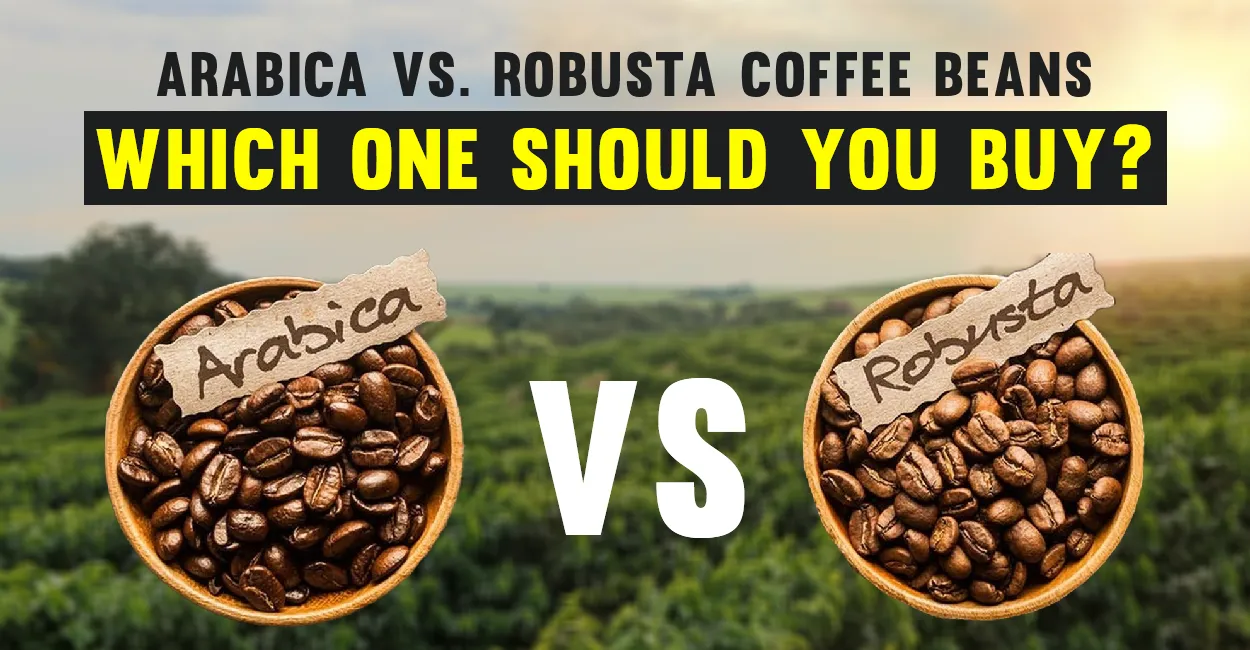When purchasing coffee beans, there is always the question of which is better: Arabica or Robusta? Hopefully, you will know labels like “100% Arabica” or “Robusta” on the bags with cookies. But what do these names mean? And how do they influence your coffee?
Arabica and Robusta are the two main types of coffee beans. Together, they represent almost 95 percent of the world’s coffee. Both types have unique tastes and smells and contain varying amounts of caffeine. Therefore, it does make a difference which is chosen. In this post, we will discuss the differences between these two types of coffee beans.
By the end, you will be aware of which bean is best suited to your cup. From a nonprofessional drinker to a coffee lover, knowledge of these beans prepares you for the best brew.
10 Key Differences Between Arabica and Robusta
Below are the critical differences between these two types of coffee beans. Let’s find out their different characteristics.
1. Arabica vs. Robusta: Flavor Profile
Compared with robusta, arabica beans are recognized for their mild, sweet, and sometimes fruity tones that contain a little chocolate or sugar. They possess a blunt taste and rich flavors and are thus considered the best option for most coffee consumers.
Conversely, Robusta beans, used in espresso, have a coarser taste and more bitterness with virtually undertones of grains. Robusta contains twice as much caffeine as the regular Arabica, which gives it a sharper, harsher taste, sometimes compared to a woody or nut-like taste.
2. Arabica vs. Robusta: Caffeine Percentage
There are two primary varieties of coffee beans: Arabica and Robusta. The latter contains almost twice the caffeine content of the former. Arabica beans contain about 1% of these acids, while Robusta beans contain about 4%, depending on the degree of roast.
Although Robusta beans have slightly less than 5% caffeine, they can have up to 2. 7%. This is because Robusta contains more caffeine than the other types. While this makes it more stimulating, it also contributes to its bitterness, making it less palatable to those who like mild coffee.
3. Arabica vs. Robusta: Growing Conditions
Arabica plants grow best in regions with complex topography, under conditions that are, on average, 2,000 to 6,000 feet above sea level and with cooler temperatures. They are more complicated and challenging to grow because they demand certain conditions before increasing correctly.
In contrast, Robusta flowers are hardy and resilient. They can grow at lower altitudes in warmer climates and are extra resistant to pests and sicknesses, which makes them simpler to farm.
4. Arabica vs. Robusta: Price and Availability
Arabica coffee is generally highly-priced because of its extensive cultivation and the required developing conditions. The sensitive nature of Arabica plants also results in lower yields, contributing to their higher fees. Robusta, which is less complicated to grow and abundant, is less expensive. This affordability makes Robusta a usual choice for instant espresso and espresso blends.
5. Arabica vs. Robusta: Shape and Size
Thus, Arabica and Robusta beans are easily differentiated by size and shape. Regarding physical appearance, Arabica is oval-fashioned and slightly curved in the middle line, while Robusta is small and round. All these physical changes represent the growth pattern of plant life; the Arabica plant is shorter, while the file Robusta plant grows taller.
6. Arabica vs. Robusta: Chlorogenic Acid (CGA) Content
Chlorogenic acids are the organic substances in the coffee beans that bear the responsibility for the taste and nutritional values of the coffee. Robusta beans contain higher ranges of chlorogenic acids, giving them a bitter taste and high antioxidant content. Arabica beans have slightly lower CGA ranges, giving them a milder taste; this is what coffee lovers prefer.
7. Arabica vs. Robusta: Global Production
Arabica dominates worldwide coffee bean production, accounting for about 75% of the coffee supply. Countries like Brazil and Colombia are leading manufacturers of Arabica coffee beans. While less famous, Robusta makes up around 25-40% of worldwide coffee bean production, with Vietnam being the largest manufacturer.
The choice between Arabica and Robusta ultimately comes down to individual preference, as both provide specific characteristics and health benefits.
8. Arabica vs. Robusta: Usage in Coffee Blends
Arabica beans are preferred for specialty blends and are usually used in regional coffees to showcase their tastes. Because Robusta contains more caffeine and a bitter note, they are generally employed in blended coffees, particularly in espresso, to contribute to the thickness of the crema.
Although Robusta is widely known as low-quality coffee, high-grade Robusta can produce good coffee when appropriately blended.
9. Arabica vs. Robusta: Plant Height and Yield
Arabica plants usually thrive at a height of 2. 5 to 4. They grow five tetrameters tall and yield coffee cherries more than the other types of plants. Meanwhile, plants grow 6 meters tall and bear cherries more than Mylan. This means that they produce better and are cheaper for the growers.
This is because Robusta yields a higher yield, which makes it preferable in commercial coffee production.
10. Arabica vs. Robusta: Sugar and Lipid Content
Arabica has higher sugar and fat concentrations than Robusta, making its blends smooth and sweet. It also contributes to the caramelization process during roasting, thus increasing the complexity of the Arabica flavor. A cup of Robusta contains lower amounts of sugar and lipids, making providing a fuller and more potent flavor easier.
Arabica vs. Robusta: Which One Is Right for You?
Choosing between Arabica and Robusta depends on your preference for coffee. Arabica has a light, soft taste with tones of fruit and a cocoa finish, which makes it preferred by many coffee lovers. Hence, coffee is often viewed as the superior and higher-end malt beverage because of its rich blended flavors and comparatively lesser caffeine content.
On the other hand, Robusta has a more robust, bitter taste, with an undertaste of earth and nuts. It has more caffeinating compounds than the different beans, which some coffee drinkers prefer as it helps to produce a good crema in espresso blends. While Arabica is generally more famous, Robusta has characteristics that can be appealing, especially in blends that combine the strengths of both types.
Ultimately, there’s no definitive answer as to what is better. It all comes down to your taste preferences and how you enjoy your coffee. Arabica might be your choice if you pick a sweeter, more sensitive taste. But if you like your espresso robust and severe, Robusta may be the higher-demanded—or maybe a blend of both for a balanced experience.
People Also Ask
Which coffee is more robust, Arabica or Robusta?
Robusta coffee is usually more potent than Arabica. Its beans contain nearly two times the amount of caffeine as Arabica beans, giving it a more robust and sour taste.
Why is Arabica coffee more expensive than Robusta?
Arabica coffee is relatively more expensive than Robusta coffee for various reasons. Arabica beans are more demanding and need specific conditions to grow, such as high altitude and cooler temperatures, which raises the cost of manufacturing.
Besides, Arabica plants yield less than Robusta and are vulnerable to diseases and pest attacks. The beans also go through a more thorough tinning process to make sure that not only does their superior, more prosperous, more complex taste contribute to the value.
Final Thoughts
As can be seen, the decision to use Arabica or Robusta coffee depends on personal choice and expected experience. Arabica contains less bitterness and caffeine and is more often chosen by customers who love their coffee with less intensity. On the other hand, Robusta is heavier, bitter in taste, and has a high caffeine content; thus, it is preferred for those desiring a robust cup of coffee.
The choice is narrow depending on personal preferences; some people like the natural taste of Arabica, while others like the strength of Robusta. Therefore, the best choice is one that best suits your tongue and, more importantly, the one you prefer when brewing coffee.

